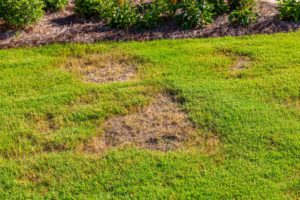
Learn how to spot and then treat heat or drought-stressed turf on your property.
Consistent hot and dry weather over long periods can lead to heat stress for your lawn, turning grass brown. Grass naturally adjusts to hot weather by entering a dormant condition to conserve energy. However, prolonged severe drought and heat can damage or even kill your lawn. What can you do to help your heat-stressed turf? The first step is spotting signs of lawn stress. Then, you can take a few steps to provide extra care for your lawn.
Look for Signs of Lawn Stress
Heat and drought stressed turf is not difficult to identify. The first signs of heat and drought stress may be when footprints appear blue/gray and remain on the grass hours after you walk on it. When stress substantially impacts your turf, grass blades may curl or brown at the tips. If you spot brown patches on your lawn, this could be a result of different problems, including:
- If the turf in these areas can be easily lifted, you may have root damage from a grub infestation
- If it is difficult to push a screwdriver into your lawn, the lawn may need moisture and aeration
- A brown lawn may also result from surface-feeding insects or fungal diseases.
If you are dealing with pests in your yard, contact the experts at Scientific Plant Service to determine the problems and develop solutions.
How to Treat Heat-Stressed Grass
After spotting the heat stress, it’s time to treat the damaged grass and help it flourish again. There are a few things you can do to increase the health of your yard:
- Consider aeration. If your yard experiences a lot of foot traffic or heavy mowing equipment, the soil will become compacted, making it difficult for air and water to reach the roots. Aeration relieves compaction and the stress on your roots.
- Water deeply, but not often. Watering lightly daily produces shallow roots that cannot handle hot or dry weather very well. Instead, your lawn so that the top six inches of soil are moistened. Wait until the soil dries before watering again. Water in the morning to avoid the high evaporation rates in the afternoon.
- Adjust fertilizer applications. In high-stress periods, light fertilizer applications can keep your lawn healthy and assist in recovery.
If you have a newly-planted lawn, don’t let it go dormant. Letting new immature turf go into drought stress can have devastating long-term effects because its shallow roots may not be able to recover from heat and drought stress.
Scientific Plant Service Is Your Go-To Source In Landscape Healthcare
Scientific Plant Service, located in Baltimore, is a privately owned corporation, chartered in Maryland in 1957 by Frank J. Burke. We started as a full-service Arborists specializing in the care of shade trees and ornamental shrubs, but today we are a Lawn Care company that is a huge part of the community. From aquatic environments and snow management to deer and mole control, SPS has services tailored specifically for your lawn and landscape.
We offer services in Maryland, Washington, DC, and Virginia, including: Harford, Baltimore, Carroll, Frederick, Howard, Anne Arundel, Montgomery, Prince Georges, Talbot, Queen Anne’s, Calvert counties in MD, as well as Loudoun County, Fairfax County, Arlington, Alexandria, and Falls Church in VA. For more information, contact us online, or call us at 410-321-0970. Be sure to follow us on Facebook, Twitter, LinkedIn, and Pinterest.

